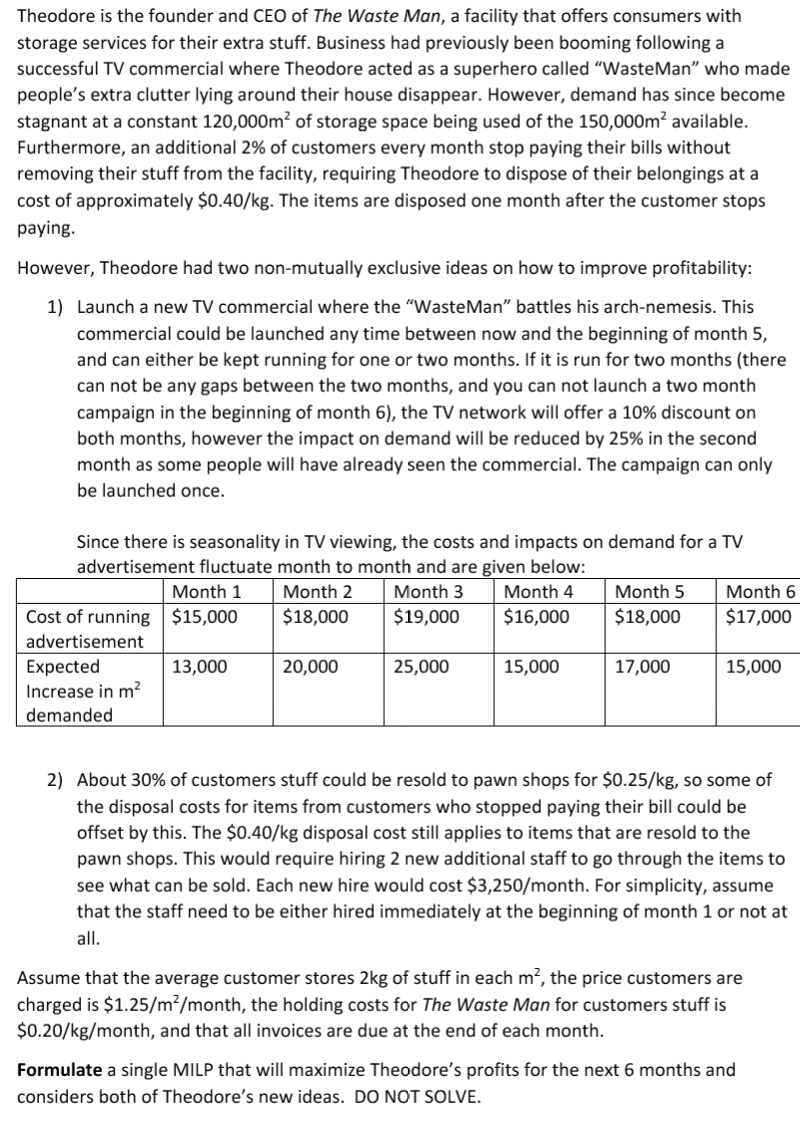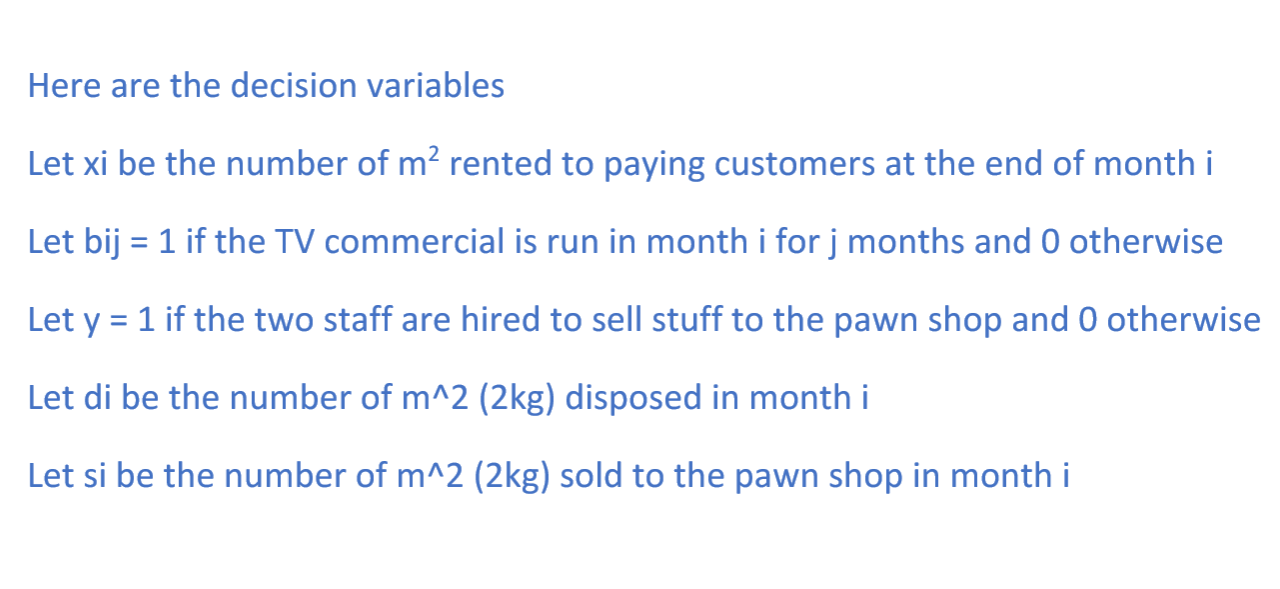

Theodore is the founder and CEO of The Waste Man, a facility that offers consumers with storage services for their extra stuff. Business had previously been booming following a successful TV commercial where Theodore acted as a superhero called "Waste Man" who made people's extra clutter lying around their house disappear. However, demand has since become stagnant at a constant 120,000m of storage space being used of the 150,000m2 available. Furthermore, an additional 2% of customers every month stop paying their bills without removing their stuff from the facility, requiring Theodore to dispose of their belongings at a cost of approximately $0.40/kg. The items are disposed one month after the customer stops paying. However, Theodore had two non-mutually exclusive ideas on how to improve profitability: 1) Launch a new TV commercial where the "Waste Man" battles his arch-nemesis. This commercial could be launched any time between now and the beginning of month 5, and can either be kept running for one or two months. If it is run for two months (there can not be any gaps between the two months, and you can not launch a two month campaign in the beginning of month 6), the TV network will offer a 10% discount on both months, however the impact on demand will be reduced by 25% in the second month as some people will have already seen the commercial. The campaign can only be launched once. Since there is seasonality in TV viewing, the costs and impacts on demand for a TV advertisement fluctuate month to month and are given below: Month 1 Month 2 Month 3 Month 4 Month 5 Month 6 Cost of running $15,000 $18,000 $18,000 $19,000 $16,000 $18,000 $17,000 advertisement Expected 13,000 20,000 25,000 15,000 17,000 15,000 Increase in m demanded 2) About 30% of customers stuff could be resold to pawn shops for $0.25/kg, so some of the disposal costs for items from customers who stopped paying their bill could be offset by this. The $0.40/kg disposal cost still applies to items that are resold to the pawn shops. This would require hiring 2 new additional staff to go through the items to see what can be sold. Each new hire would cost $3,250/month. For simplicity, assume that the staff need to be either hired immediately at the beginning of month 1 or not at all. Assume that the average customer stores 2kg of stuff in each m?, the price customers are charged is $1.25/m/month, the holding costs for The Waste Man for customers stuff is $0.20/kg/month, and that all invoices are due at the end of each month. Formulate a single MILP that will maximize Theodore's profits for the next 6 months and considers both of Theodore's new ideas. DO NOT SOLVE. Here are the decision variables Let xi be the number of m? rented to paying customers at the end of month i Let bij = 1 if the TV commercial is run in month i for j months and 0 otherwise Let y = 1 if the two staff are hired to sell stuff to the pawn shop and 0 otherwise Let di be the number of m^2 (2kg) disposed in month i Let si be the number of m^2 (2kg) sold to the pawn shop in month i Theodore is the founder and CEO of The Waste Man, a facility that offers consumers with storage services for their extra stuff. Business had previously been booming following a successful TV commercial where Theodore acted as a superhero called "Waste Man" who made people's extra clutter lying around their house disappear. However, demand has since become stagnant at a constant 120,000m of storage space being used of the 150,000m2 available. Furthermore, an additional 2% of customers every month stop paying their bills without removing their stuff from the facility, requiring Theodore to dispose of their belongings at a cost of approximately $0.40/kg. The items are disposed one month after the customer stops paying. However, Theodore had two non-mutually exclusive ideas on how to improve profitability: 1) Launch a new TV commercial where the "Waste Man" battles his arch-nemesis. This commercial could be launched any time between now and the beginning of month 5, and can either be kept running for one or two months. If it is run for two months (there can not be any gaps between the two months, and you can not launch a two month campaign in the beginning of month 6), the TV network will offer a 10% discount on both months, however the impact on demand will be reduced by 25% in the second month as some people will have already seen the commercial. The campaign can only be launched once. Since there is seasonality in TV viewing, the costs and impacts on demand for a TV advertisement fluctuate month to month and are given below: Month 1 Month 2 Month 3 Month 4 Month 5 Month 6 Cost of running $15,000 $18,000 $18,000 $19,000 $16,000 $18,000 $17,000 advertisement Expected 13,000 20,000 25,000 15,000 17,000 15,000 Increase in m demanded 2) About 30% of customers stuff could be resold to pawn shops for $0.25/kg, so some of the disposal costs for items from customers who stopped paying their bill could be offset by this. The $0.40/kg disposal cost still applies to items that are resold to the pawn shops. This would require hiring 2 new additional staff to go through the items to see what can be sold. Each new hire would cost $3,250/month. For simplicity, assume that the staff need to be either hired immediately at the beginning of month 1 or not at all. Assume that the average customer stores 2kg of stuff in each m?, the price customers are charged is $1.25/m/month, the holding costs for The Waste Man for customers stuff is $0.20/kg/month, and that all invoices are due at the end of each month. Formulate a single MILP that will maximize Theodore's profits for the next 6 months and considers both of Theodore's new ideas. DO NOT SOLVE. Here are the decision variables Let xi be the number of m? rented to paying customers at the end of month i Let bij = 1 if the TV commercial is run in month i for j months and 0 otherwise Let y = 1 if the two staff are hired to sell stuff to the pawn shop and 0 otherwise Let di be the number of m^2 (2kg) disposed in month i Let si be the number of m^2 (2kg) sold to the pawn shop in month








